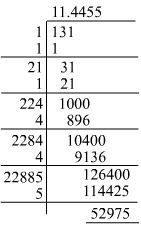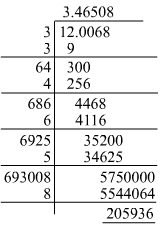RD Sharma Solutions for Class 8 Math Chapter 3 - Squares and Square Roots (Part-7) | RD Sharma Solutions for Class 8 Mathematics PDF Download
Question 2: Find the square root of 12.0068 correct to four decimal places.
Answer 2:

We can round it off to four decimal places, i.e. 3.4651.
Question 3: Find the square root of 11 correct to five decimal places.
Answer 3: Using the long division method:

 3.31662
3.31662
Question 4: Given that:
and  evaluate each of the following:
evaluate each of the following:

Answer 4: Given: √7 = 2.646
(i) 
Given: √3 = 1.732
(ii)  28.867
28.867
Question 5: Given that:  find the square roots of the following:
find the square roots of the following:

Answer 5: From the given values, we can simplify the expressions in the following manner:
(i) 
(ii) 
(iii) 
(iv) 
(v) 
Question 6: Using square root table, find the square root
7
Answer 6: From the table, we directly find that the square root of 7 is 2.646.
Question 7: Using square root table, find the square root
15
Answer 7: Using the table to find √3 and √5

=1.732×2.236=3.873
Question 8:Using square root table, find the square root 74
Answer 8: Using the table to find


=1.414×6.083
=8.602
Question 9: Using square root table, find the square root 82
Answer 9: Using the table to find 

=1.414×6.403
=9.055
Question 10: Using square root table, find the square root 198
Answer 10: Using the table to find 

=1.414×3×3.317
= 14.070
Question 11: Using square root table, find the square root
540
Answer 11: Using the table to find 


=2×3×1.732×2.2361
=23.24
Question 12: Using square root table, find the square root 8700
Answer 12: Using the table to find 

=1.7321×5.385×10
=93.27
Question 13: Using square root table, find the square root 3509
Answer 13: Using the table to find √29

=11×5.3851
=59.235
Question 14: Using square root table, find the square root 6929
Answer 14: Using the table to find √14

=13 ×6.4031
=83.239
Question 15: Using square root table, find the square root 25725
Answer 15: Using the table to find 


=1.732 ×5×7×2.646
=160.41
Question 16: Using square root table, find the square root 1312
Answer 16: Using the table to find 


=2×2×1.414×6.4031
=36.222
Question 17: Using square root table, find the square root 4192
Answer 17: 

The square root of 131 is not listed in the table. Hence, we have to apply long division to find it.

Substituting the values:
= 2×2×11.4455 (using the table to find √2)
= 64.75
Question 18: Using square root table, find the square root 4955
Answer 18: On prime factorisation:
4955 is equal to 5 × 991, which means that 
The square root of 991 is not listed in the table; it lists the square roots of all the numbers below 100.
Hence, we have to manipulate the number such that we get the square root of a number less than 100. This can be done in the following manner:

Now, we have to find the square root of 49.55.
We have: 
Their difference is 0.071.
Thus, for the difference of 1 (50 − 49), the difference in the values of the square roots is 0.071.
For the difference of 0.55, the difference in the values of the square roots is:
0.55 × 0.0701 = 0.03905
 7+0.03905=7.03905
7+0.03905=7.03905
Finally, we have:
 ×10=7.03905×10=70.3905
×10=7.03905×10=70.3905
Question 19: Using square root table, find the square root 99/144
Answer 19:

 (using the square root table to find √11)
(using the square root table to find √11)
=0.829
Question 20: Using square root table, find the square root 57/169
Answer 20:
 (using the square root table to find
(using the square root table to find 
0.581
Question 21: Using square root table, find the square root 101/169
Answer 21:

The square root of 101 is not listed in the table. This is because the table lists the square roots of all the numbers below 100.
Hence, we have to manipulate the number such that we get the square root of a number less than 100. This can be done in the following manner:

Now, we have to find the square root of 1.01.
We have:

Their difference is 0.414.
Thus, for the difference of 1 (2 − 1), the difference in the values of the square roots is 0.414.
For the difference of 0.01, the difference in the values of the square roots is:
0.01 × 0.414 = 0.00414
∴  1+0.00414=1.00414
1+0.00414=1.00414
 ×10=1.00414×10=10.0414
×10=1.00414×10=10.0414 
Question 22: Using square root table, find the square root
13.21
Answer 22: From the square root table, we have:

Their difference is 0.136.
Thus, for the difference of 1 (14 − 13), the difference in the values of the square roots is 0.136.
For the difference of 0.21, the difference in the values of their square roots is:
0.136×0.21=0.02856
 3.606+0.02856≈3.635
3.606+0.02856≈3.635Question 23: Using square root table, find the square root
Answer 23: We have to find 
From the square root table, we have:

Their difference is 0.107.
Thus, for the difference of 1 (22 − 21), the difference in the values of the square roots is 0.107.
For the difference of 0.97, the difference in the values of their square roots is:
0.107×0.97=0.104 4.583+0.104≈4.687
4.583+0.104≈4.687
Question 24: Using square root table, find the square root 110
Answer 24:
=1.414×2.236×3.317 (Using the square root table to find all the square roots)
=10.488
Question 25: Using square root table, find the square root
1110
Answer 25:
=1.414×1.732×2.236×6.083 (Using the table to find all the square roots )=33.312
Question 26: Using square root table, find the square root
11.11
Answer 26: We have:

Their difference is 0.1474.
Thus, for the difference of 1 (12 − 11), the difference in the values of the square roots is 0.1474.
For the difference of 0.11, the difference in the values of the square roots is:
0.11 × 0.1474 = 0.0162
 3.3166+0.0162=3.328≈3.333
3.3166+0.0162=3.328≈3.333
Question 27: The area of a square field is 325 m2. Find the approximate length of one side of the field.
Answer 27: The length of one side of the square field will be the square root of 325.
∴ 

=5×3.605
=18.030
Hence, the length of one side of the field is 18.030 m.
Question 28: Find the length of a side of a sqiare, whose area is equal to the area of a rectangle with sides 240 m and 70 m.
Answer 28: The area of the rectangle = 240 m × 70 m = 16800 m2
Given that the area of the square is equal to the area of the rectangle.
Hence, the area of the square will also be 16800 m2.
The length of one side of a square is the square root of its area.
∴

=2×2×5 
 =129.60 m
=129.60 m
Hence, the length of one side of the square is 129.60 m
FAQs on RD Sharma Solutions for Class 8 Math Chapter 3 - Squares and Square Roots (Part-7) - RD Sharma Solutions for Class 8 Mathematics
| 1. What is the method to find the square root of a perfect square number? |  |
| 2. How can we determine if a number is a perfect square or not? |  |
| 3. Can we find the square root of a negative number? |  |
| 4. What is the square root of 0? |  |
| 5. Is the square root of a number always positive? |  |





















